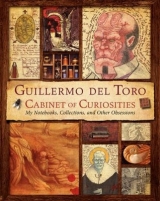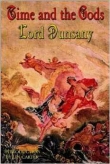
Текст книги "Cabinet of Curiosities: My Notebooks, Collections, and Other Obsessions"
Автор книги: Guillermo del Toro
Соавторы: Marc Scott Zicree
Жанры:
Публицистика
,сообщить о нарушении
Текущая страница: 1 (всего у книги 17 страниц)
Annotation
Over the last two decades, writer-director Guillermo del Toro has mapped out a territory in the popular imagination that is uniquely his own, astonishing audiences with Cronos, Hellboy, Pan’s Labyrinth, and a host of other films and creative endeavors. Now, for the first time, del Toro reveals the inspirations behind his signature artistic motifs, sharing the contents of his personal notebooks, collections, and other obsessions. The result is a startling, intimate glimpse into the life and mind of one of the world’s most creative visionaries. Complete with running commentary, interview text, and annotations that contextualize the ample visual material, this deluxe compendium is every bit as inspired as del Toro is himself.
Contains a foreword by James Cameron, an afterword by Tom Cruise, and contributions from other luminaries, including Neil Gaiman and John Landis, among others.
Guillermo del Toro
FOREWORD
INTRODUCTION
BEGINNINGS
AT HOME
A LIFE FULL OF WONDER
COLLECTIONS
BLEAK HOUSE
THE FOYER
THE HORROR LIBRARY
THE DOWNSTAIRS HALLWAY
THE HAUNTED MANSION ROOM
THE RAIN ROOM
CASA DEL TORO
THE ART ROOM
THE STEAMPUNK ROOM
THE STUDIO
THE STAIRCASE
THE SCREENING ROOM
THE COMIC BOOK LIBRARY
THE BACKYARD
GRAPHIC INSPIRATIONS
GUILLERMO’S MUSINGS ON SYMBOLIST ART
FÉLICIEN ROPS (1833–1898)
ARNOLD BÖCKLIN (1827–1901)
ODILON REDON (1840–1916)
CARLOS SCHWABE (1866–1926)
ANALYZING FILM
GUILLERMO AND ME
STORYTELLING
GUILLERMO’S MAINSTAYS OF HORROR
MARY SHELLEY (1797–1851)
EDGAR ALLAN POE (1809–1849)
ARTHUR MACHEN (1863–1947)
H. P. LOVECRAFT (1890–1937)
IDEA INCUBATORS
NOTEBOOKS
CRONOS
RESURRECTION
MIMIC
THE COLLECTING INSTINCT
THE DEVIL’S BACKBONE
NOTEBOOK THOUGHTS FROM ABROAD
BLADE II
HELLBOY
PAN’S LABYRINTH
THE MAGICIAN
HELLBOY II: THE GOLDEN ARMY
MY DAYS WITH DEL TORO
PACIFIC RIM
UNFINISHED PROJECTS
MEAT MARKET
MEPHISTO’S BRIDGE
THE LIST OF SEVEN
THE LEFT HAND OF DARKNESS
AT THE MOUNTAINS OF MADNESS
AFTERWORD
ACKNOWLEDGMENTS
CREDITS
COPYRIGHT
ABOUT THE PUBLISHER
Librs.net
Благодарим Вас за использование нашей библиотеки
Librs.net
.
Guillermo del Toro
CABINET OF CURIOSITIES
My Notebooks, Collections, and Other Obsessions
To Lorenza, Mariana, and Marissa, who put up with me.

FOREWORD
ODE TO A MASTER
JAMES CAMERON
THE ARTIFACT YOU HOLD IN YOUR HANDS is an unprecedented portal into the clockworks of a wondrous mind. Guillermo del Toro’s notebooks have been compared to the codices of da Vinci for good reason: Both are representations of the creative process of a genius unique in his time and perhaps in all time. There is no one out there on the film landscape to even compare him to, and in fact describing him merely as a filmmaker is far too limiting. He is an artist of enormous and precise vision who just happens to work on the most technically complex and culturally pervasive canvas of our time, the motion picture. In another age, he would have worked with egg tempera or a quill pen and made an equally great impact. Born into the late twentieth century, his brushes are lenses and animation software, his parchment a computer screen. For Guillermo, stories emerge freshly seized from the subconscious, still wet and wriggling, in a constant stream of pen drawings and tightly inscribed notes, which then form the blueprints for his films and books.
The power of his vision comes from his ability to communicate directly with our darkest places. He has the courage to squarely face that which we daily bury to get on with the ordered delusion of our lives. We are all insane to one degree or another, and the most functional of us merely hides it the best. But in our nightmares we confront the truth of our madness, fueled by fears so primal we often can’t even speak their names. That land which we fear and suppress is Guillermo’s playground. With his demonic glee at all things macabre and grotesque, he revels in that which we shun. He is the Santa Claus of the subconscious, the court jester of the id. He is our guide through the labyrinth of our worst nightmares, a Virgil much more suited to help us face hell than that sober Roman, because of his wit, irony, and, above all, his compassionate heart.
He will take us by the hand to confront the monster we all know is at the bottom of the stairs—our own mortality. He will drag forth our worst fears and hurl them up on the screen, knowing that to give substance to their twisted forms is to rob them of their power.
Guillermo’s art fearlessly confronts life in all its beauty and horror. He sees with the wonder and stark terror of a child. His notebooks are a map of the subconscious, and his films doorways into the dungeons of our dreams, allowing us to confront our own individual hearts of darkness, to do battle and emerge victorious.
Each of his films is a jeweled clockwork of stunning detail and breathtaking design. I am privileged to be among his creative confidantes, so I have seen each one emerge and grow, even the unfinished masterpieces that the world may not get to enjoy—Mephisto’s Bridge, The List of Seven, At the Mountains of Madness, and others. Though I mourn these unborn, I also know that del Toro conjures phantasms of stunning beauty and surreal horror as effortlessly as casting shadow creatures on the wall, using only a candle and hand movements. You can’t stop him. He reaches into the whirlwind of his mind and snatches drawings and bits of narrative as fast as he can, reaping only a fraction of what roars past.
This book will give you a glimpse of that whirlwind. You will be dazzled by the artist. But I fear that by his art alone you will still not know the man, so perhaps a word about his character now, in advance, if only because we suspect that our artistic idols will always disappoint us in the flesh. Nothing could be farther from the truth in Guillermo’s case.
Guillermo has been my friend, and I’m proud to have been his, for twenty-two years. I met him when he first came to the U.S. with his directorial debut Cronos, made using his dad’s credit cards in Guadalajara. I was immediately struck not only by the caliber of his work (so far superior to my own first effort) but also by his voracious appetite for life, for art, for the grotesque and beautiful in all forms, from classic literature to comics. His personality is larger than life, magnetic, profane, and utterly sincere.
As his career took off, I watched him navigate the waters of Hollywood with increasing frustration, as he tried to apply his old-world Latin honor to a business in which honor is as alien and abstract as calculus to a fish. But he remained true to his own code, to his vision, and especially to his friends, with a loyalty that is far too rare in any walk of life, let alone the film business.
He has been there for me when I needed help on my films, an honest and forthright pair of fresh eyes, and I’ve been there for him in the same capacity. It’s less that he needs my advice than that he wants to know there’s someone in his corner.
He calls me Jaimito, “Little Jim,” and I am slight next to him, in many ways. Once at his house, he challenged me to punch his SlamMan dummy as hard as I could. I did, moving it about six inches and almost breaking my wrist. He bellowed “Jaimito, you hit like a little girl!” and proceeded to smash the thing across the room with one punch. Like his namesake, the bull, del Toro is a force of nature. Amazing that the same meaty fist can inscribe such exquisitely detailed drawings and miniscule calligraphy.
I know him as a true friend, a steadfast husband, a loving father, and the most original character I’ve ever met. His genius is protean, his moral compass finely calibrated, his humor deliciously rank, his creative passion inspirational, and his work ethic a challenge to the rest of us slackers.
If he didn’t exist, we’d have to invent him, but how do you invent the impossible?

Sketch of the Faun from Pan’s Labyrinth in del Toro’s fourth notebook (Page 12B).

Del Toro and his partner in animation, Rigoberto Mora, with his Canon 1014XL-S Super 8 camera shooting clay animation.

A bust of Mr. Barlow the vampire by Daran Holt.

A study in wing anatomy from del Toro’s Blue Notebook.

Del Toro and Mora preparing an animation set.

An automaton by Thomas Kuntz, part of the collection at Bleak House.

Notebook 4, Page 20B.

A gathering of childhood toys and trinkets at Bleak House.

A portrait of del Toro by Basil Gogos.

A dead dragon gaff at Bleak House.
INTRODUCTION
GUILLERMO DEL TORO
THE WORLD AS CABINET
“You have to believe the magic to see it.” – GUILLERMO DEL TORO
FOR GUILLERMO DEL TORO, IT ALL STARTS WITH THE EYE—or, more accurately, the lens. His keen vision processes everything, judging it, molding it to his intellectual and creative purpose, turning it to his interests and obsessions, exquisite and grotesque, and crafting it into an endless procession of indelible, unique images—some on the world stage, some utterly private.
Most private of all are his phenomenal notebooks, full of pointed observations, random thoughts, sketches from life, and wondrous drawings. At first glance, they appear to resemble those of another polymath, Leonardo da Vinci. A true modern Renaissance man with stunning capacity, vast interests, and endless enthusiasm, Guillermo del Toro invites such a comparison. Like Leonardo, Guillermo is an artist with wide interests and talents who can be hired but not bought and who approaches the way he lives with a passionate aesthetic sense.
“One of the biggest lessons Leonardo leaves for all creators is that man is the work of art,” notes Guillermo. “Obviously, the Mona Lisa is a masterpiece. The Vitruvian Man, The Last Supper—both masterpieces. We can all agree on that. But Leonardo—the man, the anatomist, the designer, the architect, the scientist—is the real masterpiece. He is his ultimate creation. So live well. Be curious and hungry and always in awe of the world.”
Leonardo is far from the only titan who inspires Guillermo del Toro in his quest to create himself. “As with da Vinci, Mark Twain is the work of art. It’s not the isolated novels, or stories, or aphorisms. It’s the man. In the same way, in the tragic sense, that is true of Oscar Wilde or Truman Capote—both of whom, I believe, had a tragic imbalance between their artistic output and their lives as socialites.”
From each of his many guides, Guillermo selects bits and pieces, playing the role of Dr. Frankenstein and the monster both, becoming the scientist who fashions himself into something simultaneously shocking and beautiful. He combines the darkness of Lovecraft, the formalism of Hitchcock, the wildness of Fellini. His distinct palette is equal parts Richard Corben, Johannes Vermeer, Edvard Munch, and his beloved symbolists—Félicien Rops, Odilon Redon, Carlos Schwabe, and Arnold Böcklin.
Guillermo is an omnivore, or more accurately, a creature who absorbs everything that draws his interest and transmutes it into something all his own. Through his sorcery we see the world transformed. His bleak and heartening vision imprints us as indelibly as a tattoo, its grimness leavened by compassion, its central characters—often children in emotional isolation—struggling to master a larger world.

Hanging at Bleak House is the original art for the poster by Richard Corben that del Toro had over his bed as a teenager, and which continues to influence his imagination.
“You write a single book and you make a single movie,” Guillermo notes, but “the reality is that you graft all of them together. You do it whether you want to or not. Renoir, the painter, put it very nicely. He said, ‘A painter paints the same tree all of his life.’”
For Guillermo, the accident of timing, of being born now, allows him to work in film. Combining all the major arts—painting, sculpture, photography, music, writing, performance—cinema melds them into a form and experience that is greater than its parts.
What has emerged through the alchemy of Guillermo’s engagement with the cinematic medium is an artist who is utterly unique—one who blends popular culture with profound ruminations on the human condition, who juxtaposes Hollywood and Latin America in equal measure, who alternates between personal, lower-budget, Spanish-language films and Hollywood tentpoles that still manage to communicate a personal viewpoint, philosophy, and aesthetic.
In fashioning his work, his self, the things he creates, and the spaces in which he moves, the totality of the face he shows the world, Guillermo projects an idiosyncratic persona, one whose resistance to classification is its greatest strength. His films, too, resist classification, although strong sympathies are felt across them. Motifs such as clockwork beings, uterine caverns, and tentacled monsters travel freely through his films and his notebooks.

Del Toro with child actor Bailee Madison on location for Don’t Be Afraid of the Dark. Child protagonists often feature in films written and directed by del Toro.

A scene in Hellboy reminiscent of the landscapes of Arnold Böcklin (1827–1901), a Swiss symbolist painter who has influenced del Toro’s aesthetic.
In his focus on these very personal obsessions, Guillermo works in a noble tradition, for the definition of a great artist often lies in his determination to fixate on things the majority deliberately ignore in order to construct an orderly life. “Eye protein” is what Guillermo calls the distinctive language of symbols and visceral figures he weaves into the tapestry of his films. “Fifty percent of the storytelling in a movie is submerged beneath the screenplay,” he says. In other words, the vast freight of meaning lies in the tension between what we can and cannot control, in the play between the conscious, the subconscious, and the unconscious. “In the symbolic and Jungian sense, and in every sense,” he adds, “I am interested by surface and beneath.”

The inside of the Cronos device, which had to be built at an enlarged scale so that it could be filmed by del Toro and his crew using the technology available to them at the time.
BEGINNINGS
The self-invention of Guillermo del Toro began on October 9, 1964, the day he was born in Guadalajara, Jalisco, Mexico.

Guillermo del Toro (front) and his brother Federico (back) at the steps of their great aunt’s home.
“I was a very strange kid,” Guillermo remembers. “I was Aryan blond. I was like a German. And I was constantly ostracized because I had super-bright blue eyes and Roy Batty—white hair and was very thin, incredibly thin. I was constantly berated as a wimp, and I identified with those shortcomings; I felt like a freak. The nice, healthy kids were all those outgoing kids with dark hair and a tan. That’s one of the reasons why my villains are like that.”
Early in his youth, an event occurred that changed Guillermo’s life forever. “My dad won the lottery when I was four years old, and we bought a bigger house. My dad’s a self-made man, a very successful businessman, but he stopped going to school when he was very young, he never read, and I think he felt funny about not having a proper library now that he was rich. So he bought a collection of books for kids that I read. It was all the classics: Hunchback of Notre Dame, Edgar Allan Poe, this and that. But the real great thing for me was that he bought several encyclopedias, The Family Health Medicine Encyclopedia and one called How to Look at Art that was ten volumes. It took you from cave paintings all the way to what was then modern art: cubism, Klee, abstract art, pop art. I read them all, several times actually, and I consulted them a lot. Those were the beginning.”

Guadalupe Gómez (del Toro’s mother) and her father, Guillermo Gómez O’Colligan, on the porch of del Toro’s great aunt’s home, where he would spend a large part of his childhood.
The mixture of the two—the study of great art and of all the disasters that can beset the human body—had a major formative effect. “I became a very young hypochondriac because of that encyclopedia. I was constantly thinking about tumors, and liver disease, and parasites in my brain, and I thought I was going to die really quick. And the art was great because I was learning about Degas, Picasso, Manet, Goya.”
Guillermo laughs, adding, “There was a moment, I will not lie, where the family medicine encyclopedia and the art books were great because they had naked ladies. So I am very grateful to Manet, as I am very grateful to certain anatomical charts.”
At the same time, Guillermo was reading comic books. “So Bernie Wrightson, or Jack Kirby, or John Romita Sr., or any of those guys were on equal footing for me in terms of how important they were. Each was as formative an influence as fine art.”

The shelf in the Art Room at Bleak House where the encyclopedias del Toro read as a child are kept.
Never one for superheroes, Guillermo found himself drawn to horror comics. “I used to buy House of Secrets and House of Mystery. They did a lot of illegal reprints and ripoffs of EC comics in Mexico.” Guillermo also recalls a Mexican comics magazine titled Traditions and Legends of the Colonial Times, “a knock-off of EC that was supposed to be based on real occurrences and legends, but that spun out of control.” It was violent, brutal, and very sexy. “They started with tame nudity, but eventually went all out, and they had incredible violence. They had these rotting corpses in colonial clothing that were absolutely amazing. And eventually, they started to lie. They started to say, ‘Oh, this happened in so-and-so,’ and I would say, ‘No, that’s not true. That’s a Nathaniel Hawthorne story, or an Edgar Allan Poe story, or a W. W. Jacobs story.’ Because I was reading books.”
The first book Guillermo bought for himself, at age seven, was Best Horror Stories, edited by Forrest J Ackerman. From then until he was twenty, Guillermo read a book every two days, every day if he could, thousands of them. “I read really inappropriate stuff for my age: Rimbaud, Baudelaire, Marcel Schwob, who was a fantastic symbolist writer, Matthew G. Lewis’s The Monk, Thomas de Quincey. I read really weird stuff, at least by provincial standards. Look, my great aunt didn’t want me to read Victor Hugo’s Notre-Dame de Paris because the local church had it on its list of forbidden books!”
By seven or eight, Guillermo also started drawing and painting and building model kits (the first he ever painted was Pirates of the Caribbean, but he gravitated toward the monster kits). He liked eating crayons but didn’t like their texture for drawing, so he used colored pencils.
“I started drawing very young because I was illustrating my horror stories,” he recalls. “I started with the illustrations and sometimes never finished the story! Normally my clients were my mother, my grandmother, and my dad, and I would sell them the issues with a great color cover. There was a story I remember called ‘The Invader,’ and it had an invisible dome covering a city, with a giant tentacled monster eating everybody in sight, and people trying to drill a hole in the dome. And I did these epic Prismacolor pencil illustrations and sold out the three issues to my captive audience.”
At the same time, Guillermo was drawing three monsters obsessively: the Creature from the Black Lagoon, Frankenstein’s monster, and Lon Chaney’s Phantom of the Opera. “And I really loved sculpting. My brother and I would do full human figures with clay and Plasticine—liver, intestines, the heart—fill them with ketchup and throw them from the roof. So I was an artistic but very morbid kid.”
Morbid, but not passive. “I was speaking at a film school in Hollywood, and I said to them, ‘Go have a life. Live. Get laid, get into a bar fight. Get knifed in the fucking thorax. Lose all your money. Make all your money back. Jump into a train.’ When I was just a child, I was observing the world, but I lived a lot, too. We used to break into abandoned houses. We explored the entire sewer system of Guadalajara on foot. And then I became really crazy as a teenager.”

Del Toro shooting his short film Geometría with his Mitchell camera.

A poster promoting Matilde, one of del Toro’s short films, featuring art and typography by the director.

Del Toro wearing sculpted and molded gelatin makeup, including fake hair and acrylic dentures and gums.

A business card from del Toro’s special effects company Necropia S.A. de C.V., surrounded by other mementos.
From age eight on, Guillermo also began making short films. Around age twenty, he fell under the tutelage of filmmaker Jaime Humberto Hermosillo, for whom Guillermo served as executive producer on Doña Herlinda and Her Son (1985), which starred Guillermo’s mother, Guadalupe. (Hermosillo saw Guadalupe in a short film Guillermo made; he thought she was a good actress and cast her in her only feature film role.)
A key piece of advice from Hermosillo was to have faith in oneself. He would often tell Guillermo, “If a road is not presented, you build one.” Embracing this advice, Guillermo worked for ten years to establish Necropia, a special effects and makeup company in Mexico, a country that previously had no such facility. Necropia provided the makeup effects for his first feature, Cronos, in 1993.
Running through all Guillermo’s work like the hum of a high-voltage current is fear, the menacing, cold beauty of a knife’s edge. Rod Serling once observed, “The greatest fear of all is fear of the unknown, which you can’t share with others.” Nevertheless, Guillermo has explored and shared that fear with millions, his films evoking a sense of communal isolation on a grand scale.
Guillermo’s films are most easily defined as horror or dark fantasy, but not of the exploitative or escapist type. Instead, he crafts a particular brand of fear-tinged fantasy that interprets the world we live in, rather than offering a separate time or place where the audience might luxuriate in imaginative denial. As Guillermo observes, “When people say, ‘Oh, fantasy’s a great escape,’ I reply, ‘I don’t think so.’ Fantasy is a great way of deciphering reality.”
Guillermo utilizes the tools of fantasy and horror to open our eyes, as a way to see the world in its totality. His films constantly play with the border between what can be seen and what remains invisible, tackling the literal and metaphorical implications of blindness and vision.
“Spiritual blindness and physical blindness, I’m afraid of both,” Guillermo says. Whether it’s the Pale Man of Pan’s Labyrinth, the Angel of Death in Hellboy II, or the other myriad characters who choose to see or not see what is right in front of them, Guillermo invites us to consider the conscious and unconscious choices we ourselves make.
Interestingly, while existential dread has been a major theme in Guillermo’s work, a different kind of fear attends his career. “The thing I’m most afraid of is success. The second thing I fear the most is failing. But I think success is more scary. I tell you, and I’m being completely honest—people may think this is PR or me bullshitting—but the day I didn’t win the Oscar for foreign film for Pan’s Labyrinth, I was happy. It’s not a reflection about the Oscar. Any prize that I don’t win fuels the fire, and every prize I win quenches it. I always say, when you’re young and unsuccessful, you don’t have the money, and if you’re not careful, when you’re old and successful, you don’t have the passion. To be put in either of those two positions is a tragedy. I think one of the toughest times in any man’s life is his twenties, because in your twenties you’re fiercely screaming who you are, but you have only half a notion of who you are. Then as you grow older, you whisper who you are, but people are closer to you, and they listen. By that time, you have half a notion, a quarter of a notion, of who you are. I think the tragedy is when you finally have all the people that you need surrounding you, and you have nothing left to say.”
For now, Guillermo’s fears have not materialized. He is a passionate artist working at the height of his abilities. At various times, Guillermo has stood at a creative crossroads, tempted by the sort of success he fears could lead to tragedy. But in each instance, he has drawn a line, claimed himself, seen past the illusory, and chosen his voice, his calling, his singular form of expression.
In building the edifice of his life and work, it’s only natural that he’d erect a structure to hold his dreams and creations—a place called Bleak House.

The upstairs hallway at Bleak House, cluttered with framed art, books, and sculptures. The collection grows daily and is periodically rearranged by del Toro.








